Source Models of the 2016 and 2022 Menyuan Earthquakes and Their Tectonic Implications Revealed by InSAR
Abstract
:1. Introduction
2. Data and Methods
2.1. Coseismic Deformations and InSAR Measurement Errors Correction of Menyuan 2016 Earthquake
2.2. Coseismic Surface Deformations of the Menyuan 2022 Earthquake
3. Results
3.1. Coseismic Slip of 2016 Event
3.2. Fault Geometry of 2022 Event
3.3. Coseismic Slip Distribution Model of 2022 Event
3.4. Coulomb Stress Changes Caused by Earthquakes in 2016 and 2022
4. Discussion
4.1. Source Model of the 2016 Event and Its Impact on the 2022 Event
4.2. Regional Tectogenesis Revealed by the 2022 Menyuan Earthquake
4.3. Tectonic Implications of the 2016 and 2022 Menyuan Earthquakes
5. Conclusions
- (1)
- Using the atmospheric error-corrected InSAR deformation field as a constraint, more reliable source mechanisms and coseismic slip distributions were obtained for the 2016 event, indicating that atmospheric errors may significantly degrade the signal-to-noise ratio of the coseismic deformation field for events with small deformation magnitudes, thus validating the effectiveness of the proposed approach.
- (2)
- The 2016 event may have released the elastic strain energy accumulated during the crustal shortening of the LLLF zone while promoting the left-lateral strike-slip movement of the western segment of the LLLF zone and the occurrence of the 2022 Menyuan earthquake.
- (3)
- The seismogenic fault of the 2022 event is the western segment of the LLLF and the eastern section of the TLSF. Additionally, the western segment of the surface rupture zone from the northern branch may terminate in the secondary branch close to the strike direction of the SN-QL.
- (4)
- The focal mechanisms of the two Menyuan earthquakes completely differed, which may have respectively released the elastic strain energy accumulated by the shallow strike slip and the deep crust shortening of the LLLF zone caused by the eastward expansion of the TP. The 2022 event also reduced the stress in the deep part of the LLLF zone, and future attention should be paid to earthquakes in the TLSF and JQHF.
Supplementary Materials
Author Contributions
Funding
Institutional Review Board Statement
Informed Consent Statement
Data Availability Statement
Acknowledgments
Conflicts of Interest
References
- Tapponnier, P.; Zhiqin, X.; Roger, F.; Meyer, B.; Arnaud, N.; Wittlinger, G.; Jingsui, Y. Oblique stepwise rise and growth of the Tibet Plateau. Science 2001, 294, 1671–1677. [Google Scholar] [CrossRef] [PubMed]
- Burchfiel, B.C.; Zhang, P.; Wang, Y.; Zhang, W.; Song, F.; Deng, Q.; Molnar, P.; Royden, L. Geology of the Haiyuan fault zone, Ningxia-Hui Autonomous region, China, and its relation to the evolution of the northeastern margin of the Tibetan Plateau. Tectonics 1991, 10, 1091–1110. [Google Scholar] [CrossRef]
- Zhang, P.; Peter, M.; Burchfiel, B.C.; Royden, L.; Wang, Y.; Deng, Q.; Song, F.; Zhang, W.; Jiao, D. Bounds on the Holocene slip rate of the Haiyuan fault, north-central China. Quat. Res. 1998, 30, 151–164. [Google Scholar] [CrossRef]
- Zhu, L.; Wang, C.; Zheng, H.; Xiang, F.; Yi, H.; Liu, D. Tectonic and sedimentary evolution of basins in the northeast of Qinghai-Tibet Plateau and their implication for the northward growth of the Plateau. Palaeogeogr. Palaeoclimatol. Palaeoecol. 2006, 241, 49–60. [Google Scholar] [CrossRef]
- Ou, Q.; Kulikova, G.; Yu, J.; Elliott, A.; Parsons, B.; Walker, R. Magnitude of the 1920 Haiyuan earthquake reestimated using seismological and geomorphological methods. J. Geophys. Res. Solid Earth 2020, 125, e2019JB019244. [Google Scholar] [CrossRef]
- Guo, P.; Han, Z.J.; Jiang, W.L.; Mao, Z.B. Holocene Left-Lateral Slip Rate of the Lenglongling Fault, Northeastern Margin of the Tibetan Plateau. Seismol. Geol. 2017, 39, 323–341. (In Chinese) [Google Scholar]
- Gu, G. Catalogue of Chinese Earthquakes; 1831 BC–1969 AD; Science Press: Beijing, China, 1989. [Google Scholar]
- Li, K.; Tapponnier, P.; Xu, X.; Kang, W. The 2022, Ms 6.9 Menyuan earthquake: Surface rupture, Paleozoic suture re-activation, slip-rate and seismic gap along the Haiyuan fault system, NE Tibet. Earth Planet. Sci. Lett. 2023, 622, 118412. [Google Scholar] [CrossRef]
- Zhang, P.; Wang, Q.; Ma, Z. GPS Velocity Field and Active Crustal Blocks of Contenporary Tectonic Deformation In Continental China. Earth Sci. Front. 2002, 9, 430–441. [Google Scholar]
- Deng, Q.; Zhang, P.; Ran, Y.; Min, W.; Yang, X.; Chu, Q. Basic characteristics of active tectonics of China. Sci. China 2003, 46, 356–372. (In Chinese) [Google Scholar] [CrossRef]
- Zhao, B.; Huang, Y.; Zhang, C.; Wang, W.; Tan, K.; Du, R. Crustal deformation on the Chinese mainland during 1998–2014 based on GPS data. Geod. Geodyn. 2015, 6, 7–15. [Google Scholar] [CrossRef]
- Fan, L.; Li, B.; Liao, S.; Jiang, C.; Fang, L. Precise relocation of the aftershock sequences of the 2022 M6.9 Menyuan earthquake. Earthq. Sci. 2022, 35, 138–145. [Google Scholar] [CrossRef]
- Liang, S.; Lei, J.; Xu, Z.; Zou, L.; Liu, J. Relocation of the aftershock sequence and focal mechanism solutions of the 21 January 2016 Menyuan, Qinghai, M S 6.4 earthquake. Chin. J. Geophys. 2017, 60, 2091–2103. (In Chinese) [Google Scholar] [CrossRef]
- Lasserre, C.; Gaudemer, Y.; Tapponnier, P.; Mériaux, A.-S.; Van der Woerd, J.; Daoyang, Y.; Ryerson, F.J.; Finkel, R.C.; Caffee, M.W. Fast late pleistocene slip rate on the leng long ling segment of the Haiyuan fault, Qinghai, China. J. Geophys. Res. 2002, 107, ETG4-1–ETG4-15. [Google Scholar] [CrossRef]
- Lasserre, C.; Morel, P.-H.; Gaudemer, Y.; Tapponnier, P.; Ryerson, F.J.; King, G.C.P.; Métivier, F.; Kasser, M.; Kashgarian, M.; Liu, B.; et al. Postglacial left slip rate and past occurrence of M ≥ 8 earthquakes on the western Haiyuan fault, Gansu, China. J. Geophys. Res. 1999, 104, 17633–17651. [Google Scholar] [CrossRef]
- Li, C.; Zhang, P.Z.; Yin, J.; Min, W. Late Quaternary left-lateral slip rate of the Haiyuan fault, northeastern margin of the Tibetan Plateau. Tectonics 2009, 28. [Google Scholar] [CrossRef]
- Jolivet, R.; Lasserre, C.; Doin, M.; Guillaso, S.; Peltzer, G.; Dailu, R.; Sun, J.; Shen, Z.; Xu, X. Shallow creep on the Haiyuan fault (Gansu, China) revealed by SAR Interferometry. J. Geophys. Res. 2012, 117, B06401. [Google Scholar] [CrossRef]
- Shao, Y.; Liu-Zeng, J.; Van der Woerd, J.; Klinger, Y.; Oskin, M.E.; Zhang, J.; Wang, P.; Wang, P.; Wang, W.; Yao, W. Late Pleistocene slip rate of the central Haiyuan fault constrained from optically stimulated luminescence, 14C, and cosmogenic isotope dating and high-resolution topography. GSA Bull. 2021, 133, 1347–1369. [Google Scholar] [CrossRef]
- Gan, W.; Zhang, P.; Shen, Z.; Niu, Z.; Wang, M.; Wan, Y.; Zhou, D.; Cheng, J. Present-day crustal motion within the Tibetan Plateau inferred from GPS measurements. J. Geophys. Res. 2007, 112, B08416. [Google Scholar] [CrossRef]
- Wang, M.; Shen, Z.K. Present-day crustal deformation of continental China derived from GPS and its tectonic implications. J. Geophys. Res. Solid Earth 2020, 125, e2019JB018774. [Google Scholar] [CrossRef]
- Huang, Z.; Zhou, Y.; Qiao, X.; Zhang, P.; Cheng, X. Kinematics of the ~1000 km Haiyuan fault system in northeastern Tibet from high-resolution Sentinel-1 InSAR velocities: Fault architecture, slip rates, and partitioning. Earth Planet. Sci. Lett. 2022, 583, 117450. [Google Scholar] [CrossRef]
- Zhang, Y.; Shan, X.; Zhang, G.; Zhong, M.; Zhao, Y.; Wen, S.; Qu, C.; Zhao, D. The 2016 Mw 5.9 Menyuan Earthquake in the Qilian Orogen, China: A Potentially Delayed Depth-Segmented Rupture Following from the 1986 Mw 6.0 Menyuan Earthquake. Seismol. Res. Lett. 2020, 91, 758–769. [Google Scholar] [CrossRef]
- Wang, H.; Liu-Zeng, J.; Ng, A.-M.; Ge, L.; Javed, F.; Long, F.; Aoudia, A.; Feng, J.; Shao, Z. Sentinel-1 Observations of the 2016 Menyuan Earthquake: A Buried Reverse Event Linked to the Left-Lateral Haiyuan Fault. Int. J. Appl. Earth Obs. Geoinf. 2016, 61, 14–21. [Google Scholar] [CrossRef]
- Li, Y.; Jiang, W.; Zhang, J.; Luo, Y. Space geodetic observations and modeling of 2016 Mw 5.9 Menyuan earthquake: Implications on seismogenic tectonic motion. Remote Sens. 2016, 8, 519. [Google Scholar] [CrossRef]
- Pan, J.; Li, H.; Chevalier, M.-L.; Liu, D.; Li, C.; Liu, F.; Wu, Q.; Lu, H.; Jiao, L. Surface rupture zone and seismogenic structure of the 2022 Menyuan Ms6.9 earthquake in Qinghai Province. Acta Geol. Sin. 2022, 96, 215–231. (In Chinese) [Google Scholar] [CrossRef]
- Han, S.; Wu, Z.H.; Gao, Y.; Lu, H.F. Surface rupture investigation of the 2022 Menyuan MS 6.9 earthquake, Qinghai, China: Implications for the fault behavior of the Lenglongling fault and regional intense earthquake risk. J. Geomech. 2022, 28, 155–168. [Google Scholar] [CrossRef]
- Li, Z.; Han, B.; Liu, Z.; Zhang, M.; Yu, C.; Chen, B.; Liu, H.; Du, J.; Zhang, S.; Zhu, W.; et al. Source parameters and slip distributions of the 2016 and 2022 Menyuan, Qinghai earthquakes constrained by InSAR observations. Geomat. Inf. Sci. Wuhan Univ. 2022, 47, 887–897. (In Chinese) [Google Scholar] [CrossRef]
- Yang, H.; Wang, D.; Guo, R.; Xie, M.; Zang, Y.; Wang, Y.; Yao, Q.; Cheng, C.; An, Y.; Zhang, Y. Rapid report of the 8 January 2022 Ms 6.9 Menyuan earthquake, Qinghai, China. Earthq. Res. Adv. 2022, 2, 100113. [Google Scholar] [CrossRef]
- Bao, X.; Zhang, R.; Wang, T.; Shama, A.; Zhan, R.; Lv, J.; Wu, R.; Fu, Y.; Liu, G. The Source Mechanism and Fault Movement Characterization of the 2022 Mw6.7 Menyuan Earthquake Revealed by the Joint Inversion with InSAR and Teleseismic Observations. Front. Environ. Sci. 2022, 10, 917042. [Google Scholar] [CrossRef]
- Luo, H.; Wang, T. Strain partitioning on the western Haiyuan fault system revealed by the adjacent 2016 Mw5.9 and 2022 Mw6.7 Menyuan earthquakes. Geophys. Res. Lett. 2022, 49, e2022GL099348. [Google Scholar] [CrossRef]
- Feng, W.; He, X.; Zhang, Y.; Fang, L.; Sergey, S.; Zhang, P. Seismic faults of the 2022 Mw 6.6 Menyuan, Qinghai earthquake and their implication for the regional seismogenic structures. Chin. Sci. Bull. 2022, 67, 1–17. (In Chinese) [Google Scholar] [CrossRef]
- Li, Y.; Jiang, W.; Li, Y.; Shen, W.; He, Z.; Li, B.; Li, Q.; Jiao, Q.; Tian, Y. Coseismic Rupture Model and Tectonic Implications of the January 7 2022, Menyuan Mw 6.6 Earthquake Constraints from InSAR Observations and Field Investigation. Remote Sens. 2022, 14, 2111. [Google Scholar] [CrossRef]
- Bekaert, D.; Hooper, A.; Wright, T.J. A spatially variable power law tropospheric correction technique for InSAR data. J. Geophys. Res. Solid Earth 2015, 120, 1345–1356. [Google Scholar] [CrossRef]
- Bai, X.; Zhang, B.; Xu, H.; Zhan, X.; Yan, Y. Atmospheric Error Correction of InSAR Co-Seismic Deformation Based on DEM and GACOS. J. Geod. Geodyn. 2023, 43, 191–197. (In Chinese) [Google Scholar] [CrossRef]
- Wessel, P.; Smith, W.H.F. New, improved version of generic mapping tools released: EOS. Trans. Am. Geophys. Union 1998, 79, 579. [Google Scholar] [CrossRef]
- Sandwell, D.; Mellors, R.; Tong, X.; Wei, M.; Wessel, P. Open Radar Interferometry Software for Mapping Surface Deformation: EOS. Trans. Am. Geophys. Union 2011, 92, 234. [Google Scholar] [CrossRef]
- Chen, C.W.; Zebker, H.A. Network Approaches to Two-Dimensional Phase Unwrapping: Intractability and Two New Algorithms. J. Opt. Soc. Am. A Opt. Image Sci. 2000, 17, 401–414. Available online: https://opg.optica.org/josaa/abstract.cfm?uri=josaa-18-5-1192 (accessed on 30 October 2020). [CrossRef] [PubMed]
- Rosen, P.; Gurrola, E.M.; Sacco, G.; Zerbker, H.A. InSAR Scientific Computing Environment—The Home Stretch; AGU: San Francisco, CA, USA, 2011. [Google Scholar]
- Xu, X.; Tong, X.; Sandwell, D.T.; Milliner, C.W.; Dolan, J.F.; Hollingsworth, J.; Leprince, S.; Ayoub, F. Refining the shallow slip deficit. Geophys. J. Int. 2016, 204, 1867–1886. [Google Scholar] [CrossRef]
- Mario, C. A novel phase unwrapping method based on network programming. IEEE Trans. Geosci. Remote Sens. 1998, 36, 813–821. [Google Scholar] [CrossRef]
- Zhou, Z.; Liu, L.; Jiang, L.; Feng, W.; Samsonov, S.V. Using Long-Term SAR Backscatter Data to Monitor Post-Fire Vegetation Recovery in Tundra Environment. Remote Sens. 2019, 11, 2230. [Google Scholar] [CrossRef]
- Li, Z.; Feng, W.; Xu, Z.; Cross, P.; Zhang, J. The 1998 Mw5.7 Zhangbei-Shangyi (China) earthquake revisited: A buried thrust fault revealed with interferomertic synthetic aperture radar. Geochem. Geophys. Geosyst. 2008, 9, Q04026. [Google Scholar] [CrossRef]
- Li, Z.; Elliott, J.R.; Feng, W.; Jackson, J.A.; Parsons, B.E.; Walters, R.J. The 2010 Mw 6.8 Yushu (Qinghai, China) Earthquake: Constraints provided by InSAR and Body Wave Seismology. J. Geophy. Res. Solid Earth 2011, 116. [Google Scholar] [CrossRef]
- Feng, W.P.; Xu, L.S.; Li, Z.H. Fault parameters of the October 2008 Damxung Mw6.3 eartqhuake from InSAR inversion and its implication. Chin. J. Geophys. 2010, 53, 1134–1142, (In Chinese with English Abstract). [Google Scholar] [CrossRef]
- Feng, W.P.; Li, Z.H. A Novel Hydrid PSO/Simplex algorithm for determining earthquake source parameters using InSAR data. Prog. Geophys. 2010, 25, 1189–1196. (In Chinese) [Google Scholar] [CrossRef]
- Jónsson, S.; Zebker, H.; Segall, P.; Amelung, F. Fault Slip Distribution of the 1999 Mw7.1 Hector Mine, California Earthquake, Estimated from Satellite Radar and GPS Measurements. Bull. Seismol. Soc. Am. 2002, 92, 1377–1389. [Google Scholar] [CrossRef]
- Okada, Y. Surface deformation due to shear and tensile faults in a half-space. Bull. Seismol. Soc. Am. 1985, 75, 1135–1154. [Google Scholar] [CrossRef]
- Fukahata, Y.; Wright, T.J. A non-linear geodetic data inversion using ABIC for slip distribution on a fault with an unknown dip angle. Geophys. J. Int. 2008, 173, 353–364. [Google Scholar] [CrossRef]
- Toda, S.; Stein, R.S.; Richards-Dinger, K.; Bozkurt, S.B. Forecasting the evolution of seismicity in southern California: Animations built on earthquake stress transfer. J. Geophys. Res. 2005, 110, B05S16. [Google Scholar] [CrossRef]
- Lin, J.; Stein, R.S. Stress triggering in thrust and subduction earthquakes, and stress interaction between the southern San Andreas and nearby thrust and strike-slip faults. J. Geophys. Res. 2004, 109, B02303. [Google Scholar] [CrossRef]
- Institute of Geology and Lanzhou Institute of Seismology (IGLIS). The Qilianshan–Hexi Corridor Active Fault System; Seismological Press: Albany, CA, USA, 1993. [Google Scholar]
- Taylor, M.; Yin, A. Active structures of the Himalayan-Tibetan orogen and their relationships to earthquake distribution, contemporary strain field, and Cenozoic volcanism. Geosphere 2009, 5, 199–214. [Google Scholar] [CrossRef]
- Xu, X.; Han, Z.; Yang, X. Seismotectonic Map in China and Its Adjacent Regions; Seismological Press: Albany, CA, USA, 2016. (In Chinese) [Google Scholar]
- Klinger, Y.; Xu, X.; Tapponnier, P.; Van der Woerd, J.R.; Lasserre, C.; King, G. High-resolution satellite imagery mapping of the surface rupture and slip distribution of the Mw~7.8, 14 November 2001 Kokoxili earthquake, Kunlun Fault, Northern Tibet, China. Bull. Seismol. Soc. Am. 2005, 95, 1970–1987. [Google Scholar] [CrossRef]
- Liu, Z.; Yu, C.; Li, Z.; Zhang, X.; Zhang, M.; Feng, W.; Han, B.; Peng, J. Co- and post-seismic mechanisms of the 2020 Mw 6.3 Yutian earthquake and local stress evolution. Earth Space Sci. 2023, 10, e2022EA002604. [Google Scholar] [CrossRef]
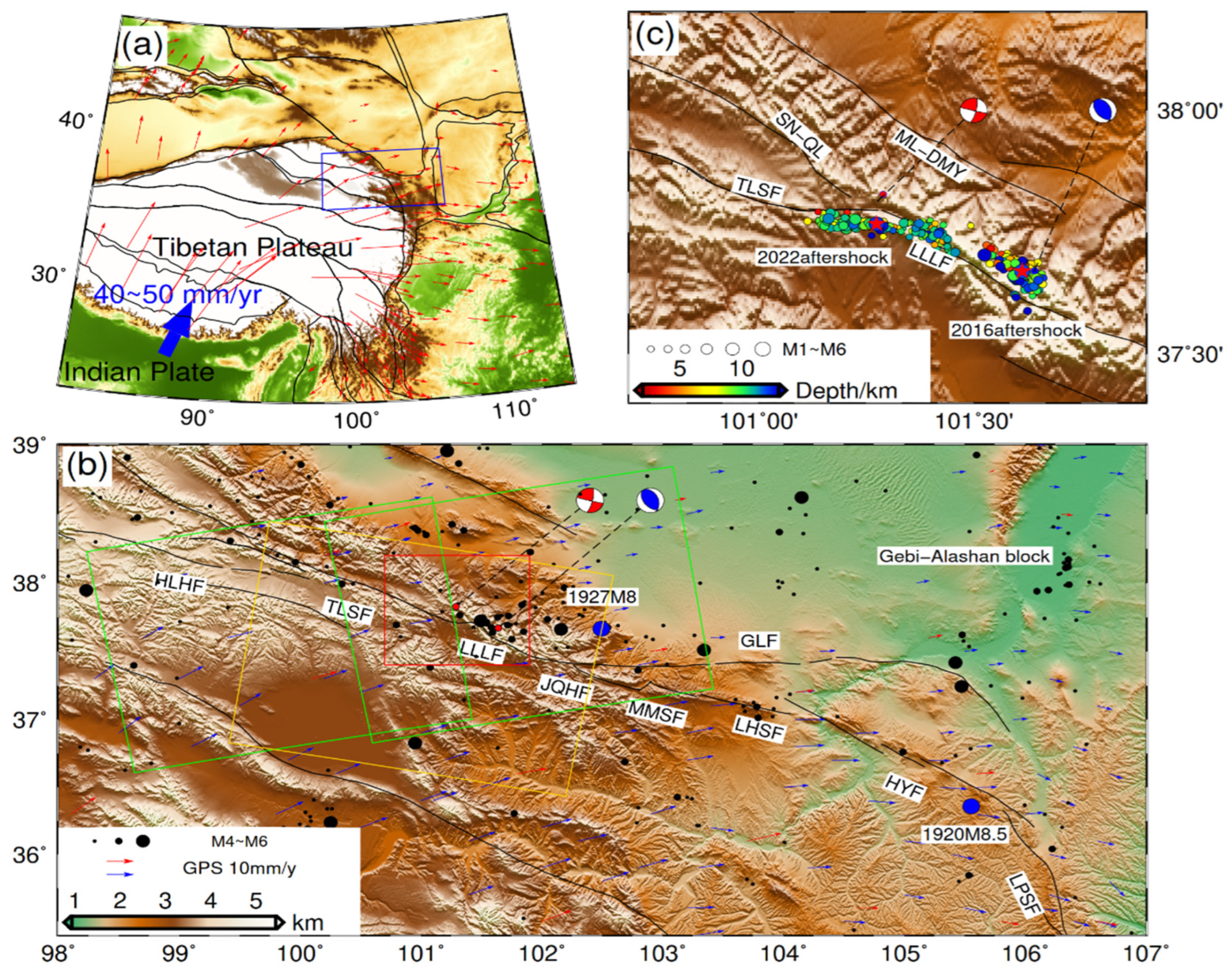
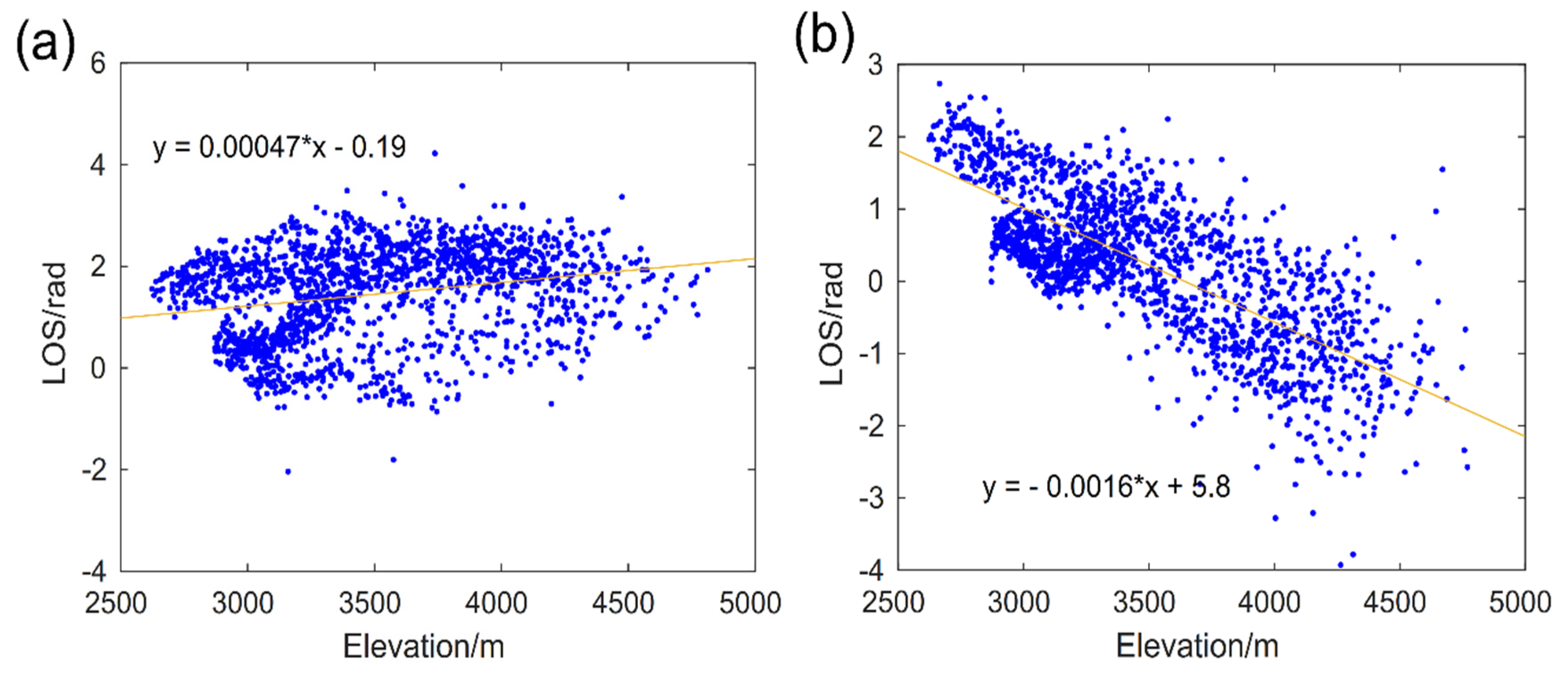
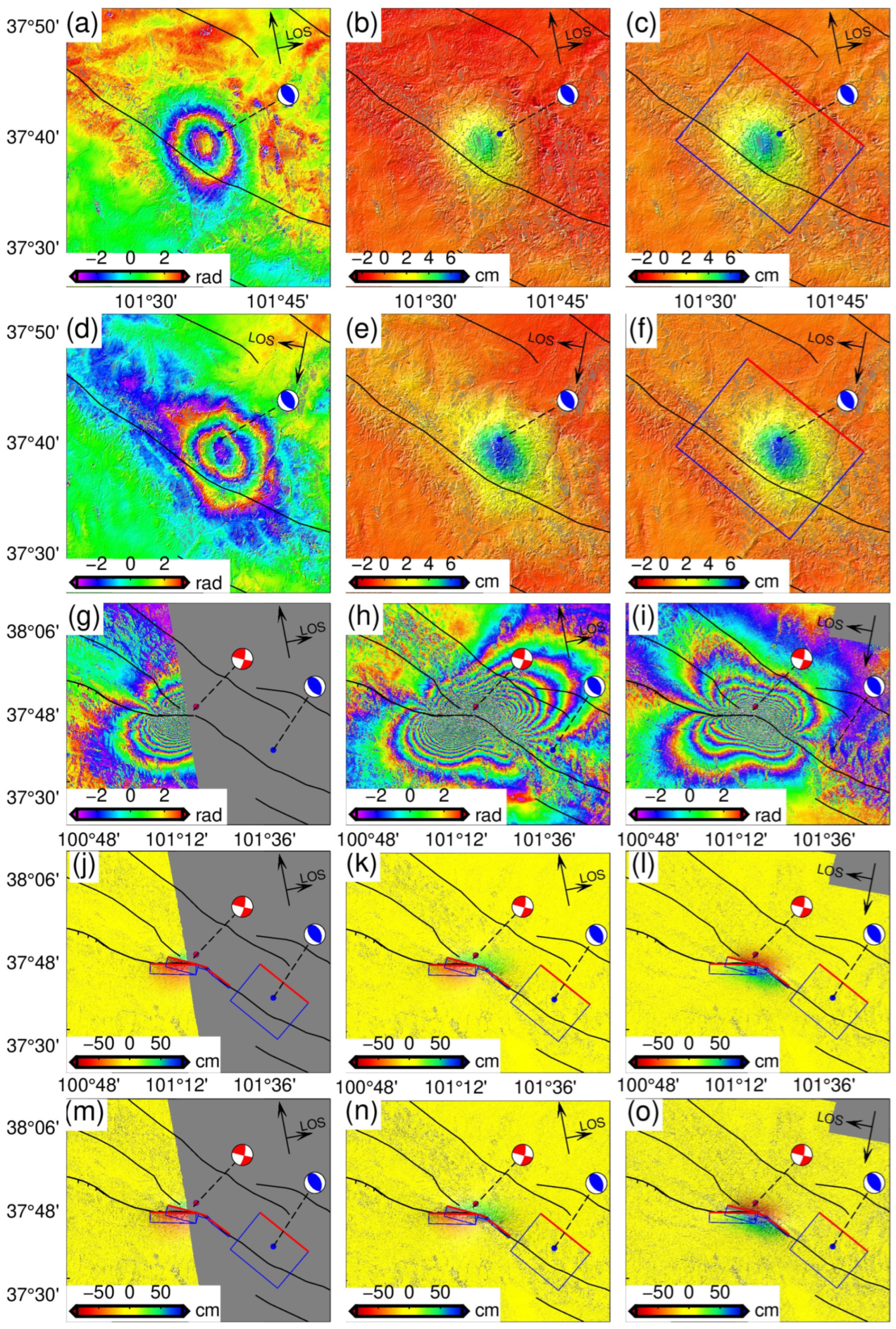



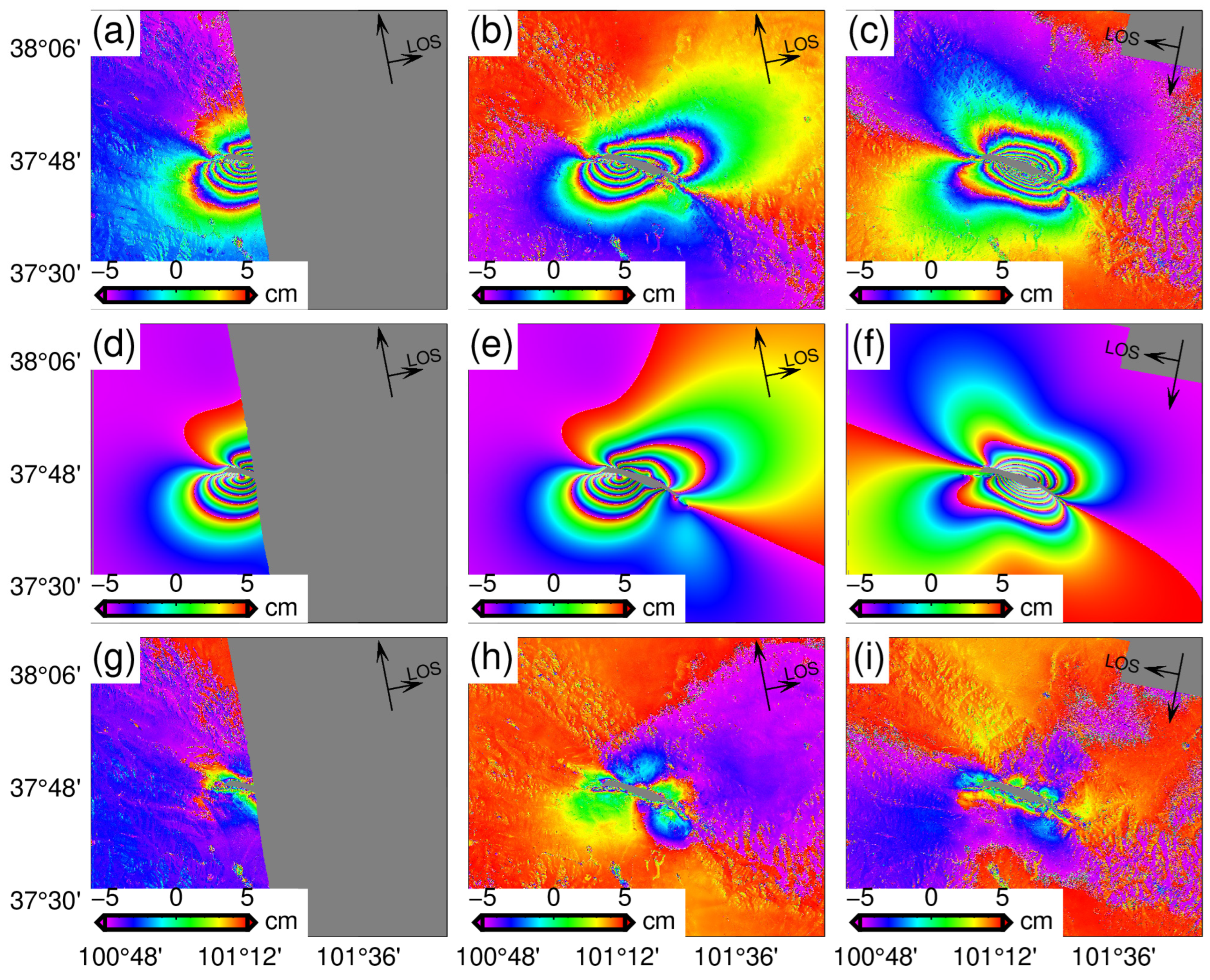
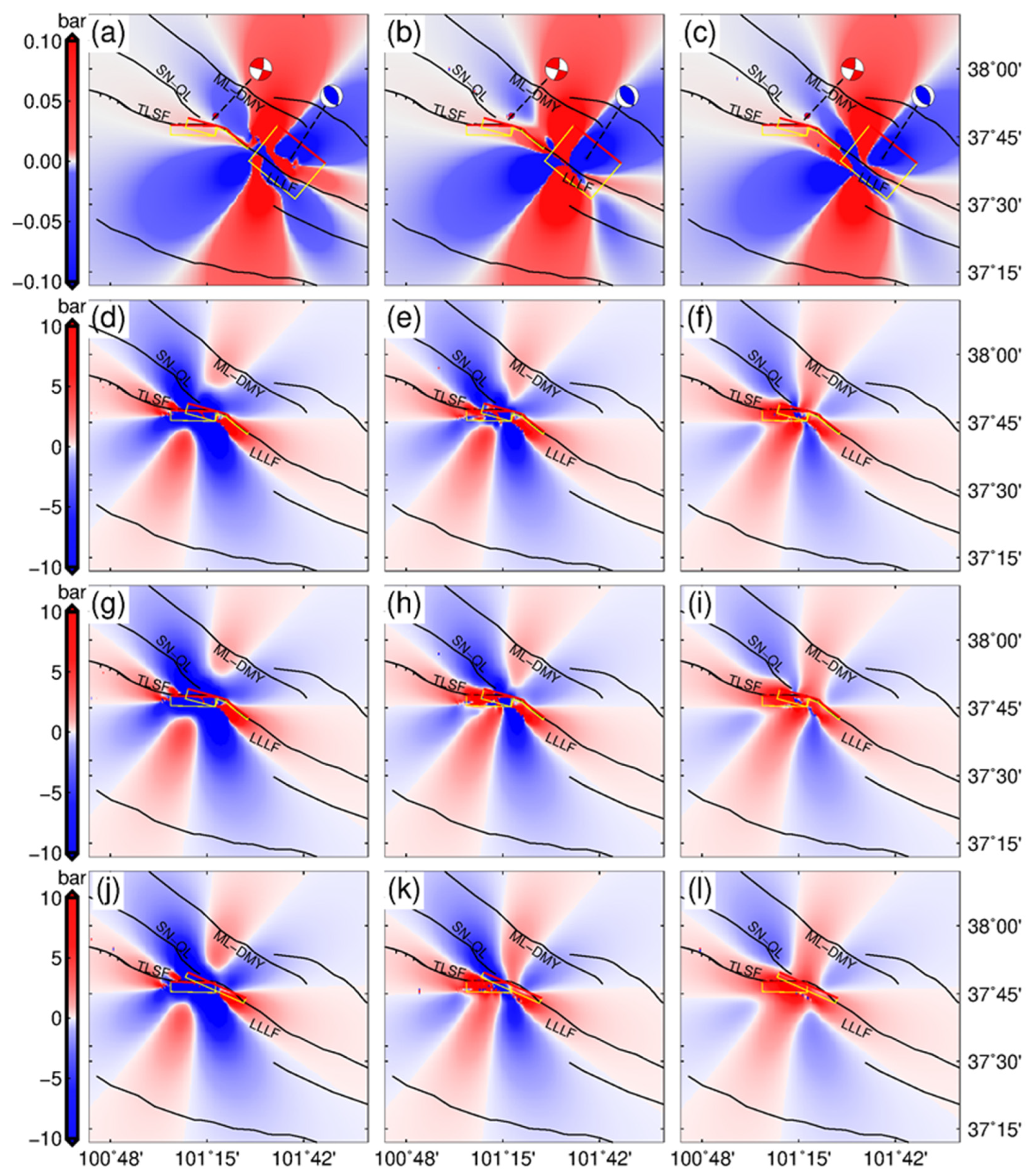
| Event | Orbit Direction | Track | Master–Slave Date | Incident Angle (°) | Azimuth Angle (°) |
|---|---|---|---|---|---|
| 2016 | Ascending | T128 | 2016/01/13–2016/02/06 | 37.6 | −10 |
| Descending | T33 | 2016/01/18–2016/02/11 | 36.1 | −169 | |
| 2022 | Ascending | T128 | 2022/01/05–2022/01/17 | 36.6 | −169 |
| Ascending | T26 | 2021/12/29–2022/01/10 | 45.3 | −169 | |
| Descending | T33 | 2021/12/29–2022/01/10 | 38 | −10 |
Disclaimer/Publisher’s Note: The statements, opinions and data contained in all publications are solely those of the individual author(s) and contributor(s) and not of MDPI and/or the editor(s). MDPI and/or the editor(s) disclaim responsibility for any injury to people or property resulting from any ideas, methods, instructions or products referred to in the content. |
© 2024 by the authors. Licensee MDPI, Basel, Switzerland. This article is an open access article distributed under the terms and conditions of the Creative Commons Attribution (CC BY) license (https://creativecommons.org/licenses/by/4.0/).
Share and Cite
Bai, X.; Zhang, B.; Guo, A.; Yan, Y.; Xu, H.; Bian, X.; Zhan, S.; Chen, J. Source Models of the 2016 and 2022 Menyuan Earthquakes and Their Tectonic Implications Revealed by InSAR. Sensors 2024, 24, 3622. https://doi.org/10.3390/s24113622
Bai X, Zhang B, Guo A, Yan Y, Xu H, Bian X, Zhan S, Chen J. Source Models of the 2016 and 2022 Menyuan Earthquakes and Their Tectonic Implications Revealed by InSAR. Sensors. 2024; 24(11):3622. https://doi.org/10.3390/s24113622
Chicago/Turabian StyleBai, Xixuan, Bingqiang Zhang, Aizhi Guo, Yi Yan, Hao Xu, Xiaoya Bian, Shuwen Zhan, and Jiangcheng Chen. 2024. "Source Models of the 2016 and 2022 Menyuan Earthquakes and Their Tectonic Implications Revealed by InSAR" Sensors 24, no. 11: 3622. https://doi.org/10.3390/s24113622






